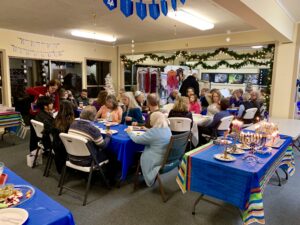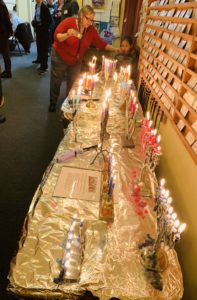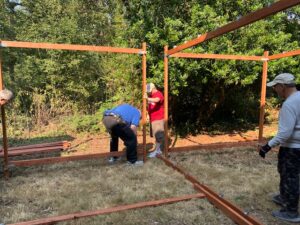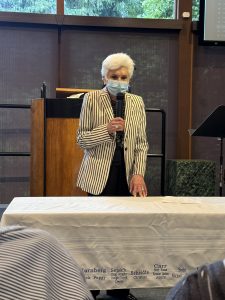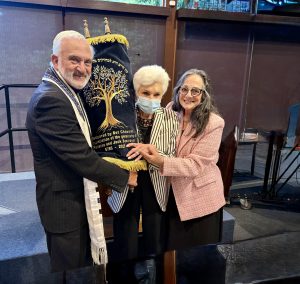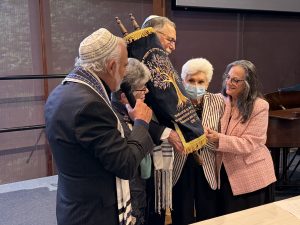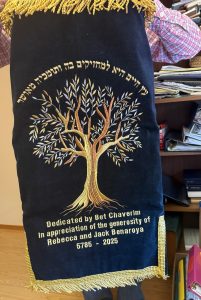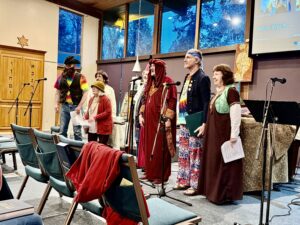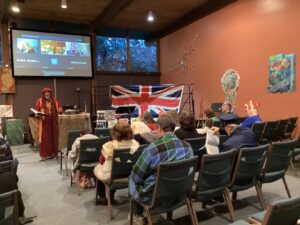< I FOUND I COULD ADD THE APP JLTV TO MY ROKU TV DEVICE. NO CHARGE FOR USE SO FAR , CARMI>
When the world shut down during the global pandemic in 2020, Jewish Life Television realized that Jews around North America would lose the chance to gather every Friday night for Shabbat Services. Given this reality, JLTV executives recognized that, since JLTV was the largest and most robust 24/7 English-language, Jewish-themed television network on the continent, it had the opportunity, even the obligation, to provide religious and spiritual support to its millions of viewers by producing and programming a weekly Shabbat Celebration.
JLTV’s Executive Vice President Brad Pomerance reached out to Rabbi Mark Blazer, the Executive Director of the Jewish Life Foundation, an independent, non-profit organization that produces and distributes Jewish-themed television programming. Rabbi Blazer agreed to take on the task, and in the spring of 2020, JLTV began to broadcast a one-hour weekly Shabbat experience that aired every Friday evening during the pandemic.
While these weekly Shabbat Services were very well-received by JLTV’s audience, neither the JLF nor JLTV anticipated that the Services would become so popular that, as the pandemic began to wind down, JLTV would receive feedback from Jewish and non-Jewish viewers alike, asking that the network continue its weekly Shabbat programming. As a result, JLTV asked, and the JLF agreed to continue producing weekly Shabbat Services for the network. Rabbi Blazer decided that if the JLF was going to continue to produce weekly Shabbat Services that would air throughout North America, he wanted those Shabbat Celebrations to reflect the diversity of North America’s Jewish community.
To meet that goal, the JLF has produced and JLTV has broadcast its Shabbats from Greenville, Houston, Los Angeles, Nashville, New York, Palm Beach, Phoenix, Seattle, and San Francisco. In April 2025, the Religion Communicator Council honored the JLF, JLTV, and Congregation Micah in Greater Nashville, Tennessee, for its production and broadcast of A Music City U.S.A. Shabbat. In the coming months, the JLF will be traveling to Boston and Columbus to produce Shabbat programming that will air on JLTV. The JLF has also produced special Shabbats when Shabbat has fallen on American Independence Day, Hanukkah, and Sukkot.
As the Jewish community welcomed the Jewish New Year earlier this month, the JLF announced a new brand for its Shabbat Services airing on JLTV – Shabbat Sessions. In addition to providing geographic diversity through its Shabbat programming, the JLF is redoubling its commitment to feature outstanding musical talent on these Services, focused not only on spirituality but also on musicality. The JLF is working with first-rate talent from the Jewish music world, including Joe Buchanan, Neshama Carlebach, Todd Herzog, Chava Mirel, Duvid Swirsky, and many more, and welcoming accomplished musicians who specialize in a variety of musical genres and styles.”
JLTV’s weekly Friday Night Shabbat Services, Shabbat Sessions, air every Friday at 7:00 PM ET and 10:00 PM ET.
JLTV is North America’s largest and most robust 24/7, English language, Jewish-themed television network, available in over 100 million homes through Charter/Spectrum, Comcast/Xfinity, Cox, DirecTV, Prime Video, Vizio, Xumo, and other traditional and non-traditional video providers.
Where to watch JLTV? Find out here!
